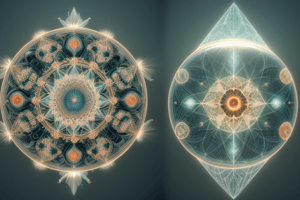Podcast
Questions and Answers
What is the process called when light changes direction upon passing from one optical density medium to another?
What is the process called when light changes direction upon passing from one optical density medium to another?
- Dispersion
- Refraction (correct)
- Reflection
- Diffraction
Which type of materials allow visible light to pass through them without scattering?
Which type of materials allow visible light to pass through them without scattering?
- Reflected
- Translucent
- Transparent (correct)
- Opaque
What do opaque materials do in terms of light?
What do opaque materials do in terms of light?
- Reflect light
- Scatter light
- Absorb or reflect light (correct)
- Allow light to pass through
How do translucent materials behave with visible light?
How do translucent materials behave with visible light?
What phenomenon involves bending white light into individual colors?
What phenomenon involves bending white light into individual colors?
Which field of science encompasses the study of light phenomena and practical applications like fiber optics and lasers?
Which field of science encompasses the study of light phenomena and practical applications like fiber optics and lasers?
What is the phenomenon when light strikes a material surface and some portion rebounds off the surface, forming an angle equal to the incident angle?
What is the phenomenon when light strikes a material surface and some portion rebounds off the surface, forming an angle equal to the incident angle?
Which law states that the angle of incidence equals the angle of reflection when light reflects off a material surface?
Which law states that the angle of incidence equals the angle of reflection when light reflects off a material surface?
Why do mirror surfaces appear bright?
Why do mirror surfaces appear bright?
When light enters different media, which mathematical formulas describe how much light bends?
When light enters different media, which mathematical formulas describe how much light bends?
Which term refers to a material's property of allowing light to pass through with minimal scattering?
Which term refers to a material's property of allowing light to pass through with minimal scattering?
How much of the incident light is reflected by non-mirrored surfaces?
How much of the incident light is reflected by non-mirrored surfaces?
Flashcards are hidden until you start studying
Study Notes
Exploring Light's Behavior and Interactions with Materials
Since ancient times, humankind has been fascinated by light — its brilliance, versatility, and countless everyday applications. As we delve into the intricate world of this fundamental force, let's shed light on several aspects surrounding light's behavior when it encounters various materials. We will explore concepts such as reflection, laws of reflection, refraction, transparency, translucency, and opaqueness through the lens of optics.
Reflection
Reflecting light is one of our most elementary interactions with it: think mirrors. When light strikes a material surface, some portion rebound off the surface, forming an angle equal to the incident angle, a phenomenon known as reflected light, governed by Snell’s Law of Reflection. This law states that the angle of incidence equals the angle of reflection, regardless of the material involved. Mirror surfaces appear bright because they reflect all incoming light back toward their source, whereas non-mirrored surfaces may only partially reflect visible wavelengths, resulting in varying degrees of glossiness.
Laws of Reflection
While simple reflection does not involve any transfer of energy between mediums, other phenomena do. Understanding these principles demands careful consideration of Snell's Law of Reflection alongside related mathematical formulas like Fresnel equations, which describe how much light bends upon entering different media.
Refraction
The process whereby light changes direction upon passing from one optical density medium to another is called refraction. For example, when you look underwater from above, fish seem closer due to refractive index differences between water and air; moreover, prisms bend white light apart into individual colors.
Transparent, Translucent, Opaque Materials
Transparent materials allow visible light to pass entirely through them without scattering. Common examples are glass windows and plastic wrap. By contrast, translucent objects scatter visible light while still allowing most of it to travel through. A classic illustration involves holding up a piece of tracing paper or frosted glass; you can see what lies beyond yet cannot distinguish precise details. Lastly, opaque materials do neither—they absorb or reflect light and block visibility altogether.
Optics
Optics refers broadly to the science of light including phenomena such as those described herein. It encompasses numerous disciplines, spanning everything from astronomy to microscopy, and even extends to practical applications involving fiber optic cables and lasers. Research within the field continues to grow increasingly diverse in scope, illuminating new avenues for discovery and innovation across industries worldwide.
Studying That Suits You
Use AI to generate personalized quizzes and flashcards to suit your learning preferences.



